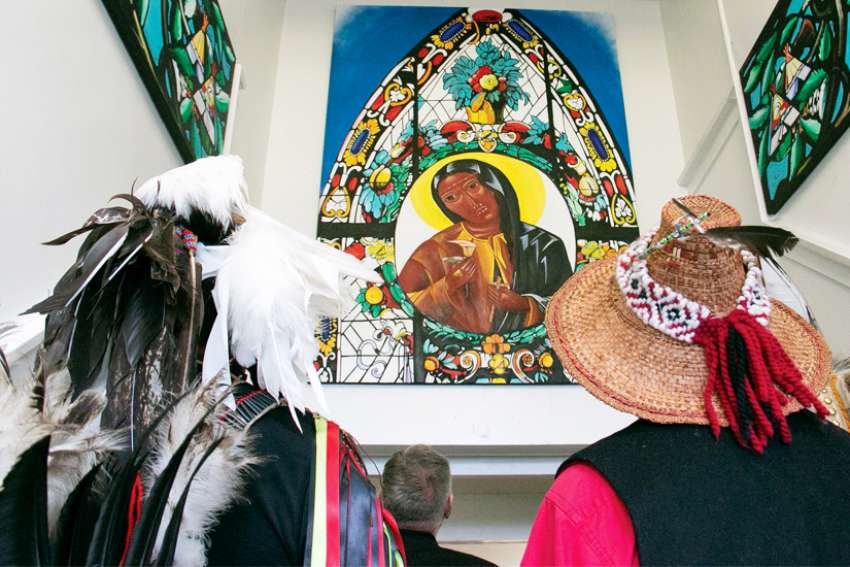The Ojibway woman is behind the provocative upside-down B.C. flag on East Hastings Street, a symbol of the province’s opioid overdose crisis. She has spray-painted displays for the Vancouver Police Museum, abstract art for Insite (the supervised drug injection site) and the striking 100-foot-wide mural featuring First Nations symbols behind the Army and Navy store.
But while Healey has dyed many streets and alleys, she has never done anything like her latest work that was unveiled in April: a simulated stained-glass window of St. Kateri Tekakwitha.
The striking image hangs at the entrance of The Door is Open, the Catholic drop-in centre that serves at least 400 free meals to the poor and homeless every day. For Healey, it is an emblem of reconciliation, inspiration and life-transforming power.
“This painting has completely changed my life.”
Healey is a survivor. A child of the Sixties Scoop, she was one of thousands of First Nations children “scooped” out of their family homes by the Canadian government between the 1960s and 1980s. She was adopted and grew up in abusive circumstances.
Healey moved from Canada’s east coast to Vancouver when she was 17 years old and quickly fell in love with the city’s energy and diversity. But life has been hard on Healey. She has suffered trauma, fought addiction, experienced homelessness and survived attempted suicide.
“I don’t know how to describe surviving every day,” she told The B.C. Catholic. “You’re like: ‘Oh my God, I gotta eat. I don’t care what it is. Put it in me.’ ”
She would rely on free meals from various non-profits, including a Catholic drop-in centre run by nuns and volunteers next to St. Paul’s Parish on East Cordova Street. She first found them about 20 years ago.
“At the time, I was in a lot of trouble,” said Healey, who was in her 20s. “I would hide in the staircase, because I didn’t know where else to go, and be comfortable for just a minute, just to take a breath. Sometimes they would open the church doors to go into the church and I would see all these beautiful paintings and these things would make me feel good.”
Healey soon came to depend on The Door is Open for its daily free meals and weekly arts and crafts program for low-income women.
“She was very attached to the place,” said Cheryl Guistra, a longtime volunteer. Guistra quickly noticed Healey had an incredible artistic eye.
She would try to catch a glimpse of Healey’s drawings in her closely-guarded sketchbook, and when she did, was always impressed. Many years later, Guistra had the opportunity to commission a local artist to decorate the entrance to The Door is Open. She knew instantly who to recommend.
Reconciliation. That was the theme Healey was asked to bring to life at The Door is Open.
“This is really important to me because it’s a huge issue among our people. A lot of them carry so much, and I get it,” said Healey.
An image of St. Kateri, the “Lily of the Mohawks” and a devout Catholic, was the obvious choice. But as Healey began work on the mural in September 2017, the project quickly became personal.
Healey’s friends have suffered abuses in residential schools and she has experienced acute suffering at the hands of prejudice herself.
She doesn’t mask her admiration for St. Kateri, a woman also intimately acquainted with suffering and ostracism. St. Kateri was orphaned at age four during a small pox outbreak. She faced ridicule both for the scars she bore from the disease and for embracing the Catholic faith. She died in 1680 of tuberculosis at age 23.
Healey’s design smoothly combines symbols of Catholic and First Nations traditions. St. Kateri is depicted on one large canvas as if on a stained-glass window, holding a lily in one hand and a cross of birch bark in the other. On canvases to either side are painted two teepees and two feathers, symbolizing harmony and unity. Mingled among them are vines, inspired by Jesus’ statement: “I am the vine, you are the branches.”
“This piece is recognizing the Church and First Nations culture,” said Healey. “I love the Church. I include it in our First Nations prayers.”
The 16-month project marked a massive turning point for Healey. Thanks to the long-term commission, she was suddenly receiving regular, monthly paycheques, and with them, a sense of purpose.
“It was a huge difference. I was able to come out of a lot of food trauma and learned how to buy and budget,” said Healey, who also goes by the name Gurl 23.
Now in her 40s, this “Sixties Scoop girl” has stable housing and a steady income. She also gives back by reaching out to at-risk Indigenous youth.
“I’m building strength. I’m building happiness. I’m building bliss. That’s what this project has done for me.”
(The B.C. Catholic)


